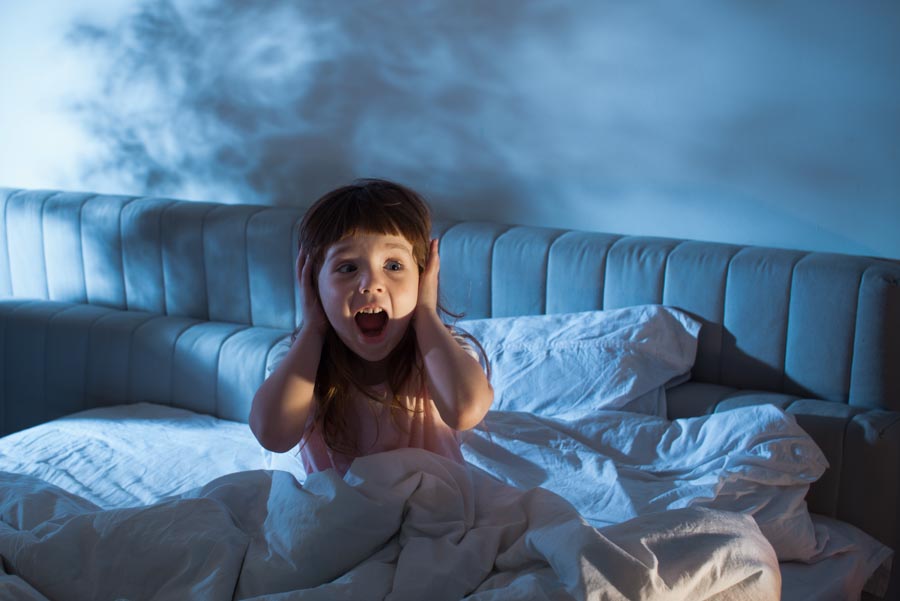Most of us remember having nightmares as children, and looking back on it we can brush it off as a normal part of childhood. However, there is a difference between the normal nightmare and night terrors. The Insomnia and Sleep Institute of Arizona is home to the “Top Doc” for the past 5 consecutive years, and we are proud to serve as your Face of Sleep Medicine in the Phoenix region. Staffed by sleep specialists who concentrate in sleep medicine, we diagnose and treat children as young as two years old as well as adults. We are driven by outcomes—which all begins with the right diagnosis.
The truth is that night terrors are a type of parasomnia, and this sleep disorder can be present in children and adults. A correct diagnosis and treatment are paramount because night terrors can be very disruptive. It is simply not sustainable to live with what is a very real sleep disorder.
The Difference Between Nightmares and Night Terrors
It is very common for children to have nightmares, oftentimes more so than adults. However, if you have noticed that your child is routinely inconsolable and their dreams just don’t seem like typical nightmares, you might be dealing with night terrors. When you experience a night terror, it is much more dramatic than a nightmare. Every person experiences night terrors a little differently, but there are some common symptoms to keep an eye on.
A person experiencing night terrors might sit up in bed, scream in their sleep, sweat, have fast breathing and a quick heartbeat, and can thrash around in bed. Understandably, this can be a very upsetting scene to experience or witness. It is worth noting that a lot of people with night terrors don’t actually remember what they were dreaming about, so they cannot recall any images. Normal nightmares can often be remembered, especially if the person is asked to describe the dream immediately after waking.
The Science Behind Night Terrors
Night terrors occur when the central nervous system is over-aroused during sleep. We sleep in cycles, and dreams as well as nightmares occur during rapid eye movement (REM) cycle. However, night terrors happen when we are not in REM. This means that a night terror isn’t actually a dream, but more akin to a reaction from a fear that occurs when a person is shifting from one stage of sleep to another.
On average, a night terror happens 2 – 3 hours after falling asleep. This is usually when a person is transitioning from a deep stage of non-REM sleep to light REM sleep. For someone without night terrors or some other sleep disorders, this is a smooth shift.
Is My Child at High Risk for Night Terrors?
Technically, anyone can have night terrors. However, there are some commonalities that have been noted among those who suffer from this condition. Those with night terrors are often highly stress, overtired, or ill. Sometimes a new medicine can kick-start or exacerbate night terrors. Sleep deprivation, too much caffeine, and new sleeping environments have also been linked to this parasomnia event.
Night terrors actually only occur in 3 – 6 percent of children, typically between the ages of 4 – 12 years old. Boys tend to be diagnosed with night terrors at a slightly higher rate than girls, but it is also important to keep in mind that many people (children and adults alike) are probably living with undiagnosed night terrors. There is also a potential genetic link to night terrors. Approximately 80 percent of children diagnosed with night terrors also have a family member with a sleep disorder like sleepwalking.
Helping Someone with Night Terrors
The best thing you can do if you suspect night terrors is to work with sleep specialists for a diagnosis and treatment. Remember that this is a parasomnia event, a genuine sleep disorder that deserves intervention. Best practices you can do at home will be individualized to your circumstances, but it is generally advised to not try to wake someone during a night terror as this can cause further disorientation.
You can also reduce stress, ensure enough rest to prevent being overtired, and create a healthy bed routine that follows sleep hygiene best practices. Not sure where to get started in achieving this? That’s where we can also help. If you are concerned about night terrors or any other possible sleep disorder, get in contact with The Insomnia and Sleep Institute today by calling (480) 745-3547 or completing the online form.





